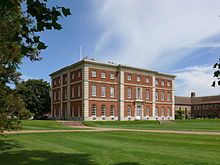Sir John Stonhouse, 3rd Baronet

Sir John Stonhouse, 3rd Baronet, PC (c.1672–1733) was an English landowner and Tory politician who sat in the
Life

Stonhouse was the eldest son of Sir John Stonhouse, 2nd Baronet of Radley and his wife Martha Brigges daughter of Robert Brigges, merchant, of St Paul’s Churchyard, London, and widow of Richard Spencer, Vintner, of Berry Street, Aldgate, London.[1] He matriculated at The Queen's College, Oxford on 12 April 1690, aged 17 and was admitted at the Inner Temple in 1690. He succeeded his father to the baronetcy in 1700.
Stonhouse was returned as
From 1721, Stonhouse had
Family
Stonhouse married twice. By his first wife Mary Mellish he had two daughters, of whom Martha married Arthur Vansittart of Shottesbrook, and was mother of Robert Vansittart, Henry Vansittart and Arthur Vansittart, MP for Berkshire.[6][7][8] His second wife was Penelope, daughter of Sir Robert Dashwood, 1st Baronet. They had nine children. Of those, three sons (John, William and James) in succession held the baronetcy. One of the daughters, Penelope, married John Leveson-Gower, 1st Earl Gower, as her second husband; another, Catherine, married Robert Lee, 4th Earl of Lichfield.[7] Anne married Sir William Bowyer, 3rd Baronet and was mother of Sir George Bowyer, 5th Baronet.[9]
Radley Hall descended to a granddaughter of the 3rd Baronet, Penelope, Lady Rivers. She was the daughter of Penelope, by her first husband, Sir Henry Atkins, 4th Baronet of Clapham; she married George Pitt, 1st Baron Rivers. Sir James Stonhouse died unmarried in 1792, leaving the Hall to Lady Rivers. Under the terms of the will, when she died in 1795, it passed to Sir George Bowyer, 5th Baronet.[10][11]
Notes
- ^ Cokayne, George Edward, ed. (1904), Complete Baronetage volume 4 (1665-1707), vol. 4, Exeter: William Pollard and Co, retrieved 10 June 2019
- ^ "Stonhouse, Sir John, 3rd Bt. (?1672–1733), of Radley, Berks., History of Parliament Online (1690-1715)". Retrieved 16 June 2015.
- ^ "RBH: History of Radley Hall, Berkshire (Oxfordshire)". Retrieved 16 June 2015.
- doi:10.1093/ref:odnb/38071. (Subscription or UK public library membershiprequired.)
- ISBN 0-7195-3328-7.
- ^ "Vansittart, Arthur (?1727–1804), of Shottesbrook, Berks., History of Parliament Online". Retrieved 16 June 2015.
- ^ William Betham (1801). The Baronetage of England: Or The History of the English Baronets, and Such Baronets of Scotland, as are of English Families; with Genealogical Tables, and Engravings of Their Coats of Arms. Burrell and Bransby. p. 318.
- doi:10.1093/ref:odnb/28103. (Subscription or UK public library membershiprequired.)
- doi:10.1093/ref:odnb/3089. (Subscription or UK public library membershiprequired.)
- ^ John Burke; Sir Bernard Burke (1844). A Genealogical and Heraldic History of the Extinct and Dormant Baronetcies of England, Ireland and Scotland. J. R. Smith. p. 27.
- ^ 'Parishes: Radley', in A History of the County of Berkshire: Volume 4, ed. William Page and P H Ditchfield (London, 1924), pp. 410–416 http://www.british-history.ac.uk/vch/berks/vol4/pp410-416 [accessed 16 June 2015].
